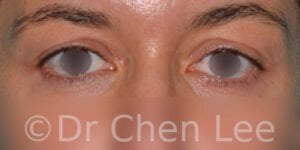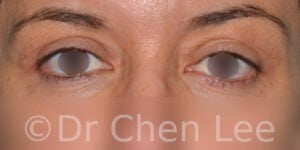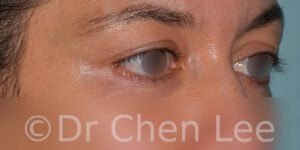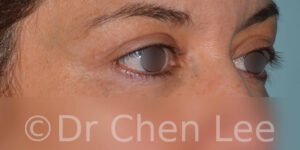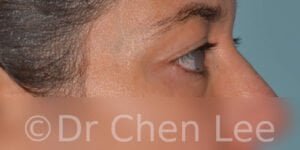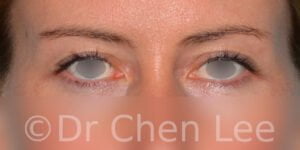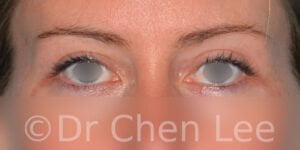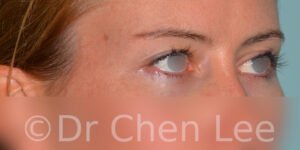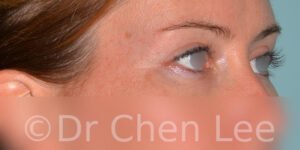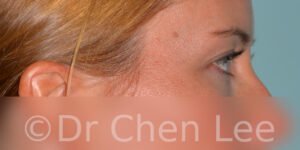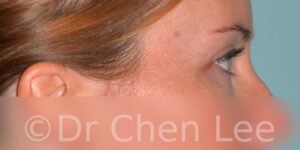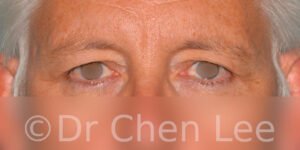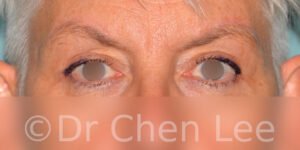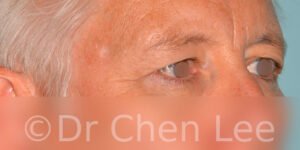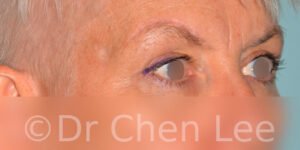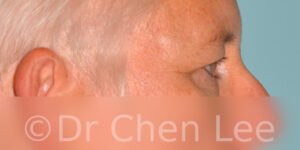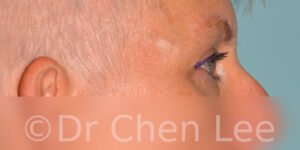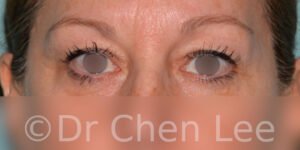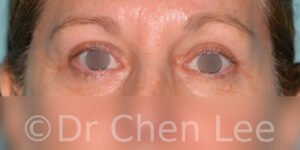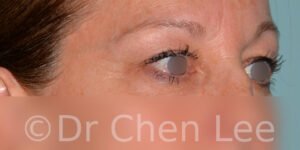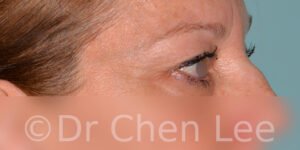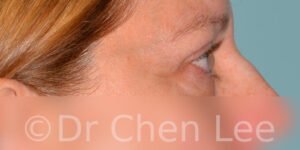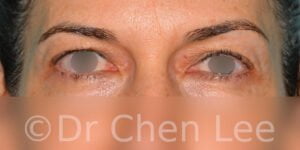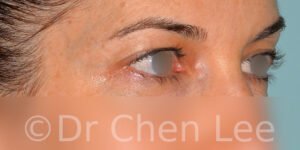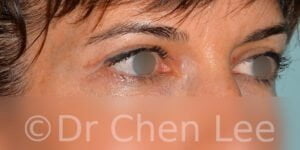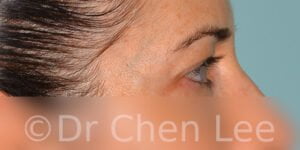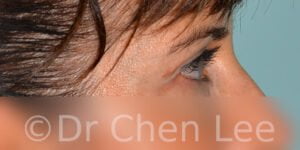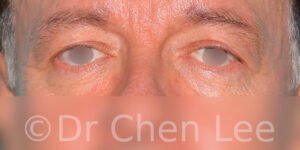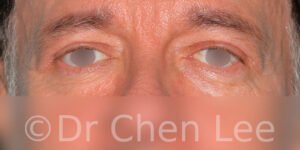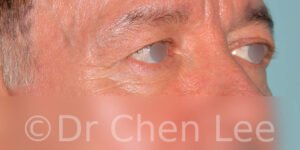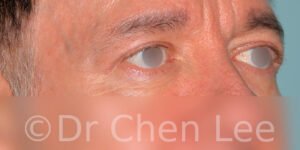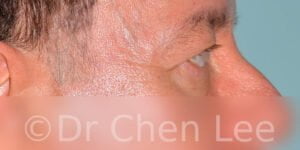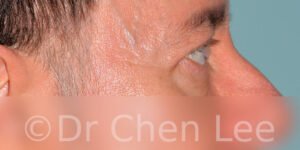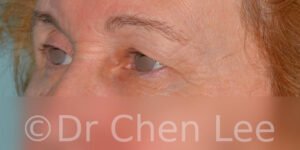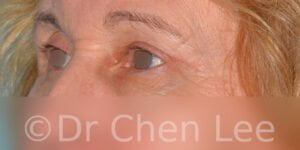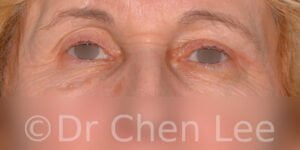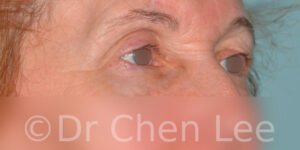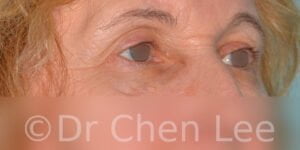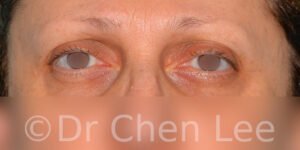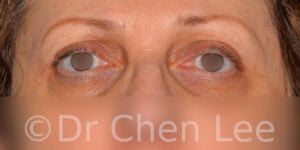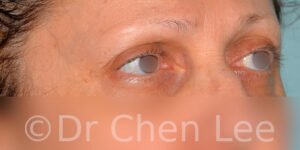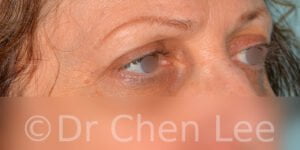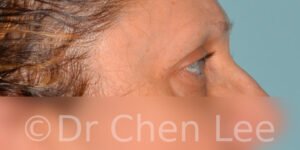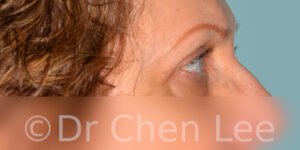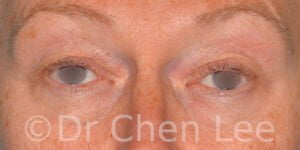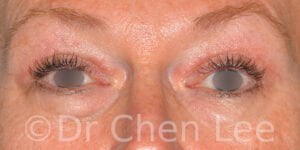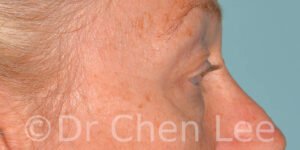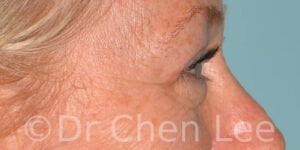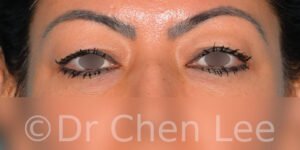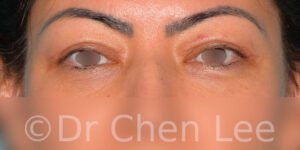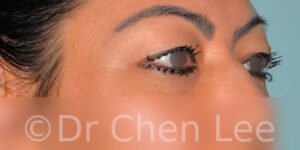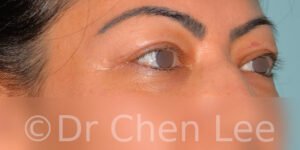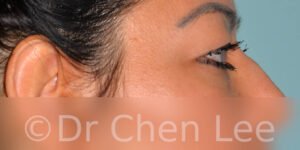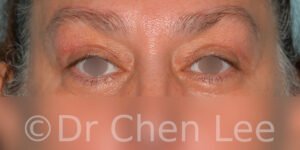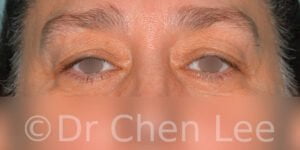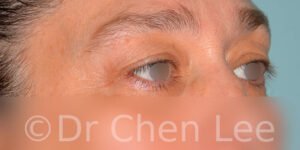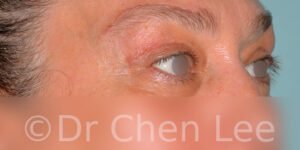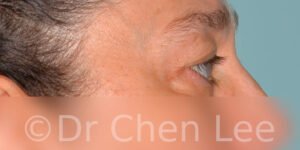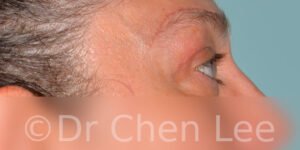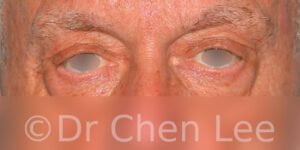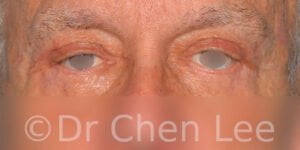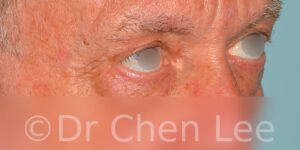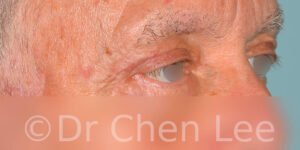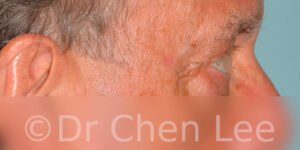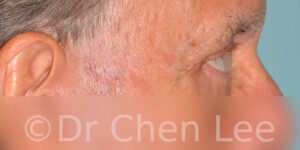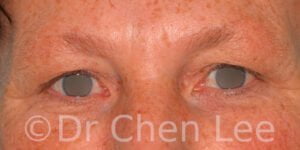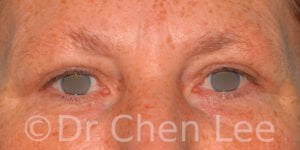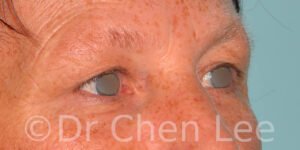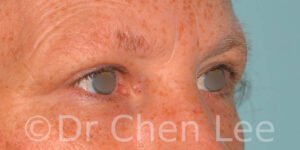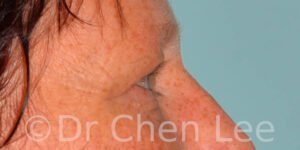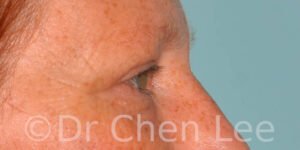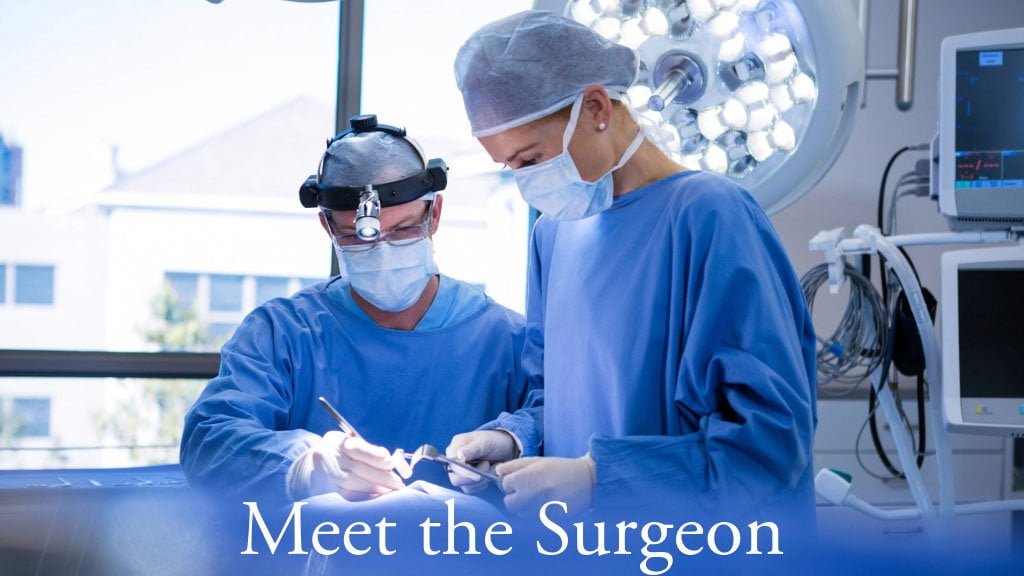Blepharoplasty
Upper eyelid surgery can change the appearance of sadness and remove the feeling of heaviness
An eyelid lift or blepharoplasty is a surgical procedure that removes skin and muscle from the upper and lower eyelids. Blepharoplasty can improve sagging skin and bags of aging eyes.
Excision of excess upper eyelid skin in elderly patients can improve vision. Blepharoplasty in Asians can add a crease to the upper eyelid without altering ethnic identity.
Blepharoplasty – The Essentials
During your consultation about your eyelids, we will talk to you about the techniques, the possible complications, the convalescence as well as the financing.
Types & Techniques
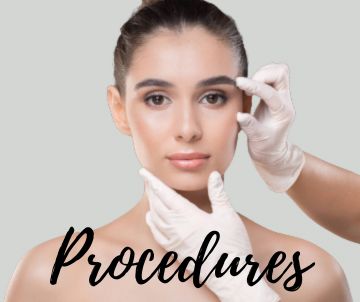
Over the years, skin and fat accumulate in the upper eyelid. This loss of ligamentous eyelid support causes skin distention, a hidden lid crease, and a sensation of upper eyelid heaviness.
What is the upper eyelid?
The upper eyelid is a movable band of flesh that helps protect and hydrate the cornea of the eye. Cosmetic surgery involves operating on the upper eyelid when its mobility or aesthetic appearance is affected.
What does the surgery consist of?
Upper blepharoplasty removes excess skin, and fat, and treats possible muscle hypertrophy.
The incision is made at the crease of the eye to make the scar completely imperceptible.
Most often, patients have upper eyelid surgery when they experience a problem with heavy, drooping eyelids. This sensation is linked to excess skin sometimes associated with pockets of fat that increase the weight on the eye and make makeup difficult for women.
The aging of the face diminishes the support of delicate eyelid structures. This results in herniated eyelid fat and sagging skin of the lower eyelids. Excision of the excess skin and fat is commonly performed as part of a lower eyelid rejuvenation surgery.
What is the lower eyelid?
The lower eyelid refers to a movable skin membrane that covers the lower half of the ocular globe. The lower eyelid maintains contact with the surface of the eye at all times. The coordinated movements of the upper and lower eyelids help maintain proper hydration of the cornea, cleanse its surface, protect it from trauma, and control the intensity of light passing to the retina.
What does lower eyelid surgery consist of?
The typical patient who seeks lower blepharoplasty desires treatment for “bags” under the eyes. This may occur due to hereditary weakness of lower eyelid ligaments or from natural age-associated changes.
Lower eyelid surgery involves making an incision at the ciliary edge (flush with the eyelashes) or inside the eyelid lining (also known as the conjunctiva) to minimize the visible scar.
Lower blepharoplasty permits the correction of asymmetries and/or rejuvenation of an aged face by look by judiciously removing excess skin, and fat, and suspending the lower eyelid orbicularis muscle.
Asian cosmetic surgery blepharoplasty also called “double eyelid operation” allows the creation of a fold or the repositioning of an existing fold.
The surgery does not transform the Asian eye into a Caucasian eye, but on the contrary, opens the contour of the eye while retaining the ethnic origins.
In addition, the surgery removes both excess skin and corrects the wrinkles between the eyelid crease and the eyelashes. The result is permanent.
The scar, hidden in the crease of the eyelid, is almost invisible.
In some cases, a “double eyelid” procedure can be performed percutaneously without scarring the eyelid skin.
This technique is particularly suitable for young patients with thin and elastic skin who wish to reorient or hollow out an already existing eyelid crease.
Pinch blepharoplasty is a technique that involves pinching the skin of the lower eyelid with forceps and cutting off only the excess skin with a scissor without peeling the skin or orbicularis muscle. Could call it “mini-blepharoplasty”
With the “pinch” technique, due to the absence of skin detachment, the risk of eyelid retraction does not exist.
The difference between the “pinch” and the classic technique is that one does not practice an exit of scar outside the external angle of the eyelid, which most often betrays blepharoplasty because the scar can be visible when it. is not hidden in the eyelashes and that it comes to hide in the wrinkles of the crow’s feet.
In addition, due to the absence of skin detachment, the postoperative course is simpler and there is much less edema and bruising than with conventional techniques.
Pinch blepharoplasty can be a great technique to treat just the excess skin. There is no eyelid lift.
Blepharoplasty Considerations
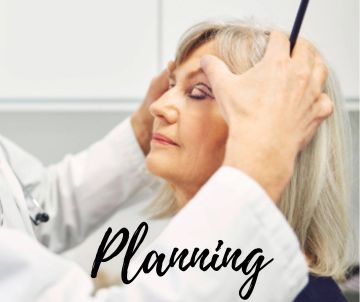
During your consultation, Dr. Chen Lee will perform a detailed clinical examination to determine the best blepharoplasty technique for your unique anatomy. A written detailed list of risks and complications will be provided. We encourage you to read it.
If you wish to pursue surgery, our office staff with work to reserve a date for the procedure.
Below are some basic recommendations to prepare for blepharoplasty:
- 2 weeks before surgery avoid the use of nonsteroidal anti-inflammatory medications (eg. Aspirin, Advil, Motrin, etc.)
- In the evening and morning before surgery, shower with an acne soap such as Spectro-Jel
- Do not apply facial cream or make-up on the day of surgery
Blepharoplasty patients are usually managed as ambulatory day surgery patients. The procedure is usually performed under local anesthesia. General anesthesia can be considered when blepharoplasty is combined with other cosmetic procedures.
A blepharoplasty procedure typically requires 1 to 2 hours to perform. Convalescence lasts 10 to 14 days.
Dr. Chen Lee regularly performs this procedure at the Metropolitan Surgery Center in Montreal. Surgeries commence early in the morning and patients are discharged in the afternoon. To prepare for surgery, experienced medical staff will greet you and review a medical checklist to ensure a safe surgery.
Following surgery:
- You must be accompanied home by a trusted friend or family member.
- We recommend that they be present in your home for the early days after surgery.
Our office will call by telephone to periodically check on your progress at home. Your first follow-up appointment will take place approximately 6 to 10 days later.
- To reduce swelling, try to maintain a sitting or semi-sitting position.
- Cool compresses applied to the eyelids reduce discomfort. Refrigerated saline solution can be used to cool and moisten the eyelid compresses.
- Take medications as prescribed.
- Maintain the Steri-Strips in place until your doctor removes them.
Contact us immediately if:
- Bleeding
- Intense pain
- Fever
Complications following a properly performed blepharoplasty are infrequent. Despite the low frequency, it is important to be aware and informed of the possible complications.
Infection: Most eyelid infections following blepharoplasty result from suture entry points. Micro abscesses can develop around the break in the skin around the suture points. This complication responds well to local wound care.
Scars: The thin skin of the eyelid usually heals very well. While unusual, it is possible for the scars to be visible and less subtle than desired.
Epidermal cysts: These can appear where the incision is placed. They will often resolve spontaneously. Persistent cysts may require excision with a subsequent minor procedure.
Epiphora: Persistent tearing is known as epiphora. This occurs more often in patients who have “dry eye” syndrome. Treatment consists of protection and lubrication of the ocular globe until the normal tear film is restored.
Lagophthalmos: The inability to completely close the eyelids is called lagophthalmos. This is possible in the early days after the blepharoplasty. It spontaneously resolves in the following weeks after surgery.
Ectropion: Retraction of the lower eyelid is known as ectropion. Severe retraction is uncommon following blepharoplasty. The minor ectropion may present as rounding of the form eyes and is more often observed in patients with preexisting laxity to the lower eyelids. Poorly tone of a lower eyelid may result in its eversion from the force of a healing blepharoplasty incision. It often will improve as the scars mature. Gentle lower eyelid massage aids in scar relaxation and is used to manage ectropion following blepharoplasty.
Retrobulbar hematoma: Blood accumulation behind the ocular globe is known as a retrobulbar hematoma. Pressure from a retrobulbar hematoma impairs the vascular circulation to the optic nerve and can result in blindness. It is a known but rare complication following blepharoplasty.
Financing & Convalescence

At the initial office consultation for blepharoplasty, Dr. Chen Lee performs a thorough examination to tailor his recommended treatment to an individual’s unique anatomy. He may use before and after photos of previous cases to explain procedures and demonstrate possible outcomes. In addition, the risks associated with the recommended treatment will be explained in detail.
The price of blepharoplasty in Montreal is quoted as a “global fee”. The price quote includes the costs of the surgeon, anesthesiologist, nurses, office visits during the first post-operative year, operating room, and surgical facility fees. Revisions and touch-up surgeries are not included in the initial eyelid surgery quotation. If general anesthesia is necessary, you will have to pay for the substantial costs associated with a surgical revision. Minor touch-up surgery under local anesthesia can often be performed at minimal expense.
Eyelid surgery pricing is proportional to its complexity. The price range for eyelid surgery is $4000 – $6000 + taxes. More accurate blepharoplasty pricing is possible only after a consultation with our plastic surgeon.
Our office requests payment in 2 equal installments. To reserve a date at the surgery center, we request an accompanying first installment (50% payment). The remaining balance is due 3 weeks before your scheduled date of surgery.
Surgeries are payable in cash, certified checks (bank drafts), and Interac. We also work with an independent credit company that offers financial payment plans for cosmetic surgery procedures. However, you should be aware that the interest rates and administration fees of this specialized company are higher than traditional financial institutions. It is often better to negotiate a loan through your personal bank or financial institution. We encourage you to do your homework and compare the true financial cost of these various financial options.
Healing is rarely painful. Some patients experience discomfort, feeling of tension in the eyelids, slight irritation of the eyes, and minor visual disturbances.
Rest and avoidance of exertion are essential for uncomplicated healing following eyelid surgery. Eyelid swelling (edema), bruises (ecchymosis), and tearing vary greatly in magnitude and duration from one individual to another.
During the first days after blepharoplasty, eyelid closure can be temporarily impaired from post-surgical tissue swelling. Similarly, the normal lid contact with the surface of the ocular globe may be disrupted. These findings most often resolve spontaneously in the first weeks after surgery. Eye lubricants are often prescribed to protect the surface of the cornea in patients temporarily affected by incomplete eyelid closure. Eyelid sutures are removed between the 3rd and 6th day after surgery.
Healing is sufficient to permit a return to a normal socio-professional life after 14 to 20 days. Scars often remain red for several months. The application of cosmetic makeup to the eyelids is permitted 14 days after eyelid surgery.
FAQ – EYELID SURGERY – BLEPHAROPLASTY
Blepharoplasty will not remove wrinkles at the corners of the eyes, eliminate dark circles under the eyes, or lift the eyebrows. Eyelid surgery cannot stop the aging process. It can, however, reduce the appearance of aging in the eyelid area. Blepharoplasty is customized to meet the particular needs of each patient. It can be performed in conjunction with other plastic surgical facial procedures such as facelifting, forehead lift, and rhinoplasty.
It is natural to have questions. Dr. Chen Lee is determined to help you understand the objectives of blepharoplasty and its risks so that you are in a position to make an informed decision.
Prospective candidates should be in good health, have no serious or active illnesses, no pre-existing medical conditions, and should have realistic expectations of the outcome of eyelid surgery.
You can optimize your blepharoplasty outcome by adhering to the guidelines below:
- Prior to your eyelid surgery, it is important to inform us of all the prescribed medications that you are taking.
- 2 weeks prior to eyelid surgery stop taking and/or avoid taking blood-thinning over-the-counter medication such as aspirin or any other nonsteroidal anti-inflammatory medications. This will minimize the risk of bleeding and hematoma.
- Stop smoking 3-4 weeks before and after surgery.
- Do not drink alcohol before surgery.
- If the surgery is performed under general anesthesia, you must be fasting for 8 hours before the surgical procedure.
- Eyelid swelling can be considerable. Planning a stay-at-home companion for 24-48 hours adds reassurance and security.
Upper or lower blepharoplasty procedures usually require 1 hour of operative time to perform.
For the upper eyelid, the incision is concealed in a natural skin crease. Excess skin, muscle, and fat are excised and are oriented along the upper lid crease. Lower eyelid blepharoplasty usually is performed by making an incision under the ciliary margin. This lid incision permits skin tightening and provides access for the excision of excess fat. An internal conjunctival incision of the lower eyelid is an option for patients with isolated fat excess in the lower eyelids,
Blepharoplasty incisions are closed with fine caliber sutures. Suture removal is usually planned in the first postoperative week. Scars are concealed by natural skin creases and eyelashes. The procedure is most commonly performed under local anesthesia. Blepharoplasty patients are managed as ambulatory outpatients.
Yes. Nonsurgical options include skin resurfacing and filler injections.
Common skin resurfacing techniques to manage mild to moderate skin excess of the lower eyelids include chemical peel and laser resurfacing. Contour irregularities such as tear troughs can be improved with hyaluronic acid injection.
Aging lessens the tone and elasticity of eyelid structures. This is exacerbated by tobacco smoke and chronic exposure to sunlight. The loss of structural lid support results in drooping eyelids and a sensation of heaviness. When severe, the excess skin can obstruct the visual axis and impair vision. Functional and visual impairment from excess upper eyelid skin is covered by most health insurance carriers.
In Quebec, the Régie de l’Assurance Maladie du Québec (RAMQ) will offer coverage to patients with severe upper eyelid dysfunction provided that care is rendered by a plastic surgeon who enrolled in their program and the surgery is performed at a publicly funded institution.
Dr. Chen Lee is not affiliated with RAMQ. His eyelid surgery procedures are performed at private facilities and are not eligible for RAMQ coverage.
Low impact activities such as brisk walks, stationary cycling, and training on an elliptical exercise machine can be resumed 3 weeks after blepharoplasty. High impact activities such as running and high-intensity fitness classes can resume 6 weeks after surgery. Contact sports that involve the risk of eye or eyelid trauma (i.e. martial arts) should be suspended for a minimum of 3 months.

